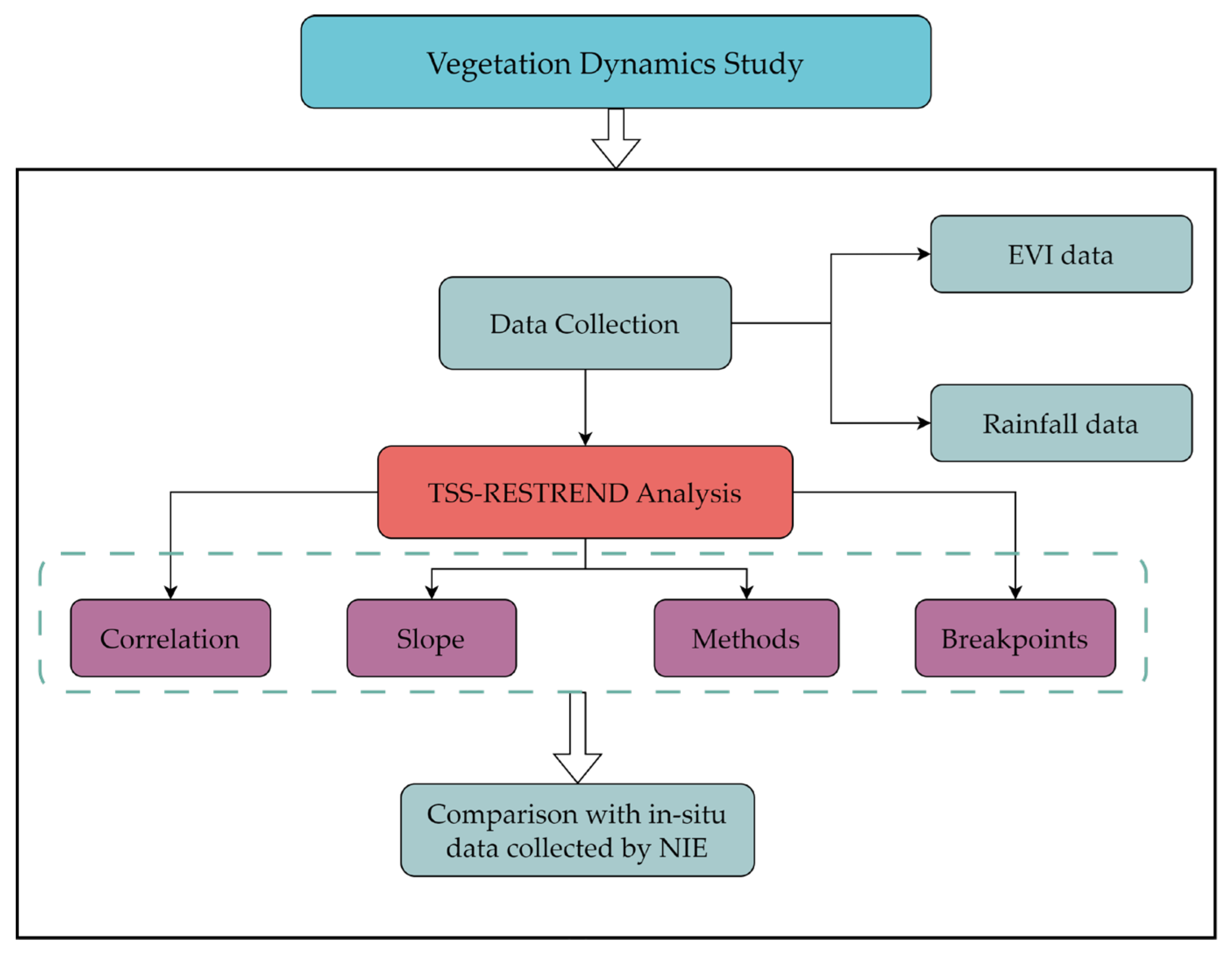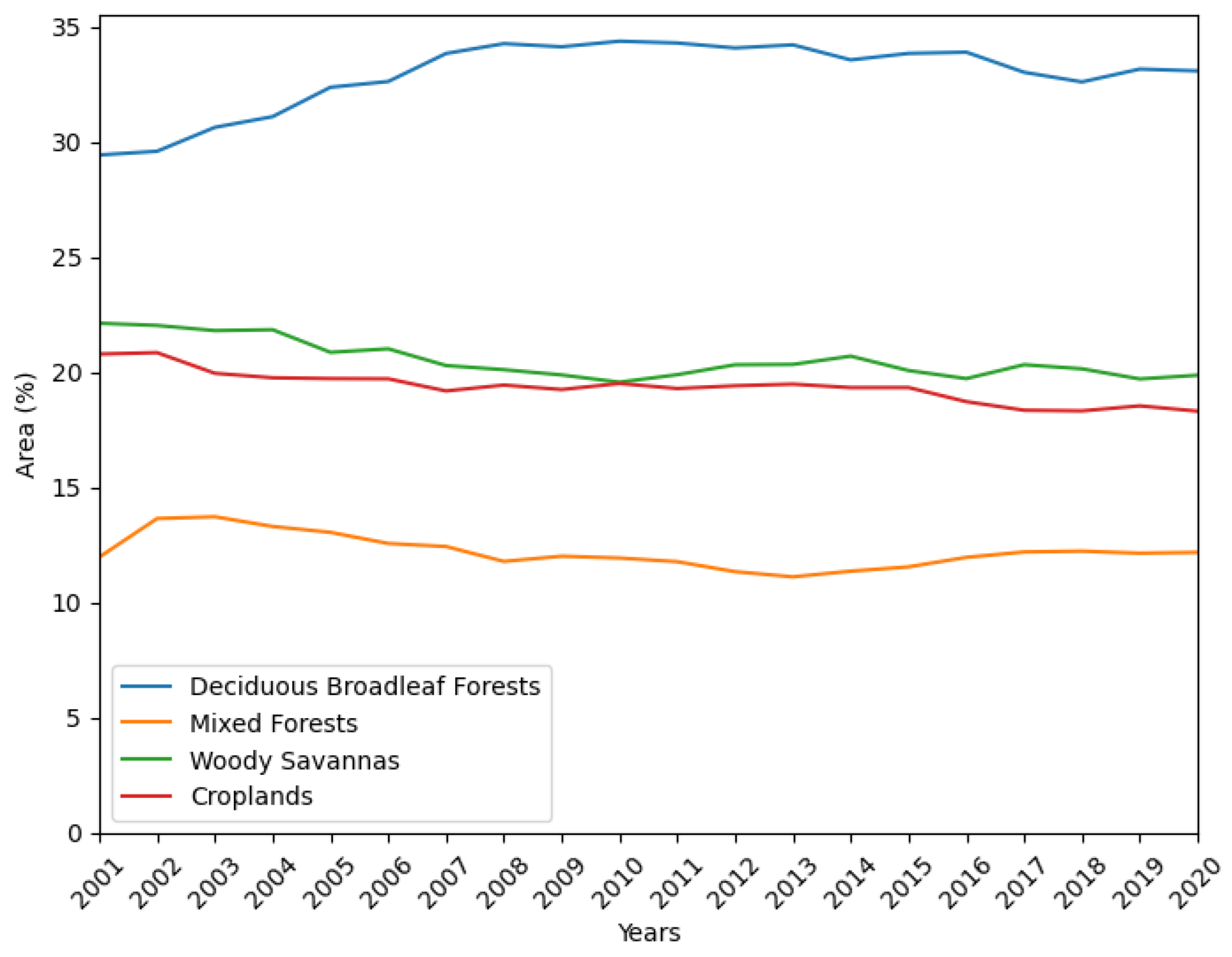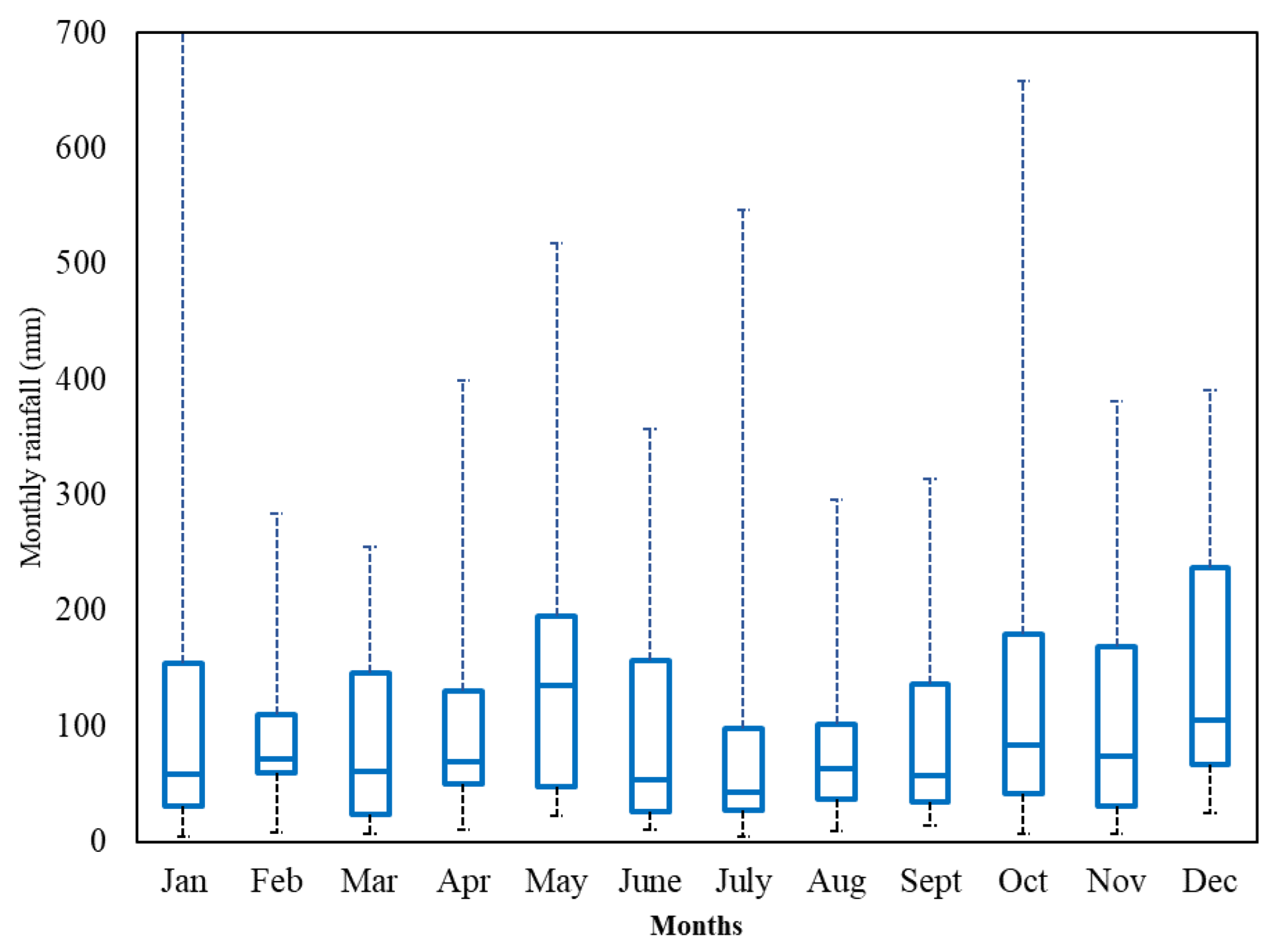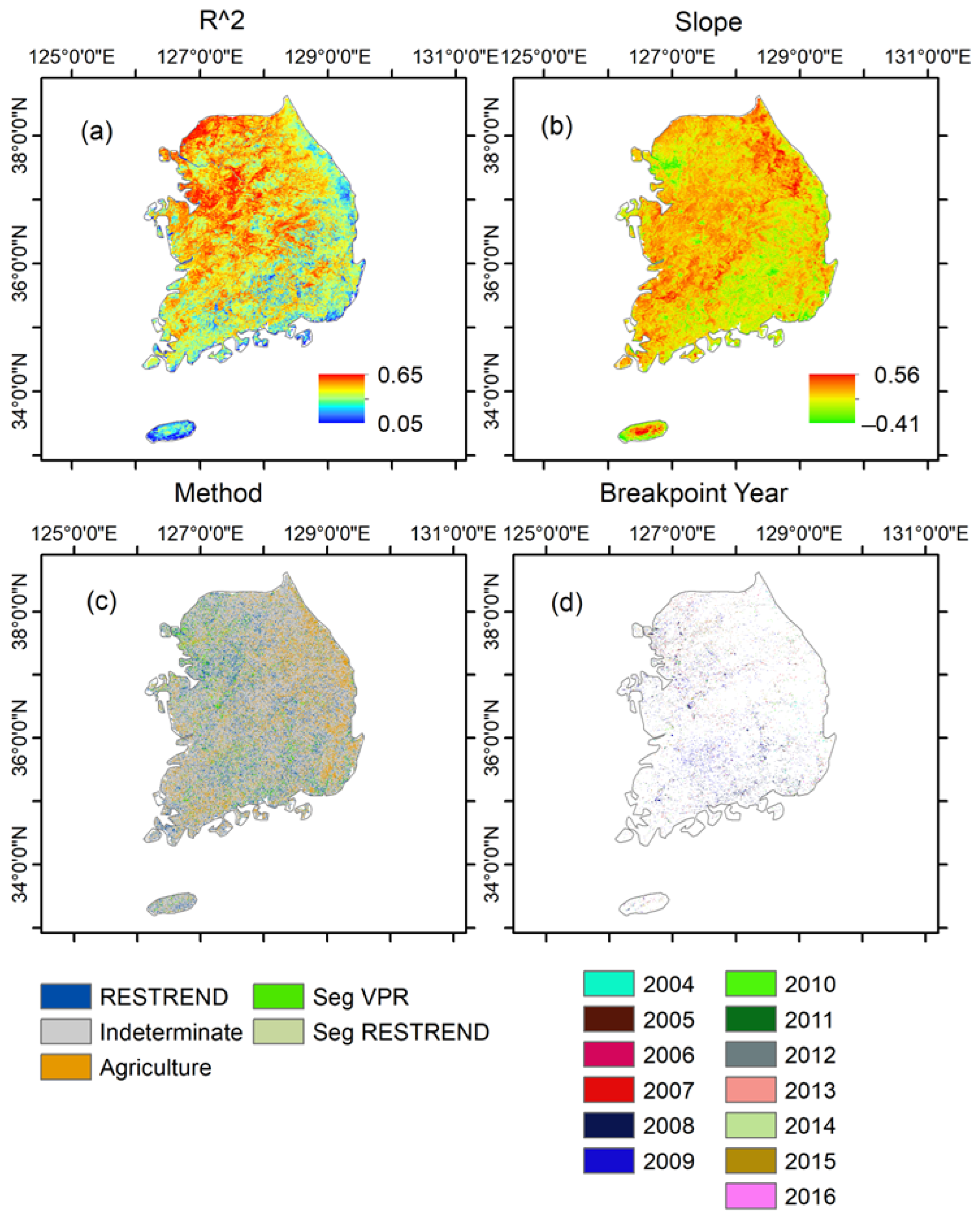Examining the Dynamics of Vegetation in South Korea: An Integrated Analysis Using Remote Sensing and In Situ Data
Abstract
1. Introduction
2. Materials and Methods
2.1. Study Area and Data
2.2. TSS-RESTREND
- (1)
- VPR computation involves ordinary least squares regression, which models the association between the annual EVI and the logarithm of the optimal accumulated precipitation. Optimal accumulated precipitation is determined on a per-pixel basis, identifying the accumulation period (1–24 time periods) and off-set period (1–3 time periods) that yield the highest correlation coefficients with EVImax in a calendar year. The disparity between the observed EVI and the EVI predicted by the identified VPR at each time step is recognized as the VPR residual.
- (2)
- BFAST is employed on the VPR residuals, now regulated for rainfall. The statistically significant breakpoints detected by the BFAST method throughout the time series necessitate further testing of their impact on primary productivity (EVImax). For pixels with a significant VPR (α = 0.05), a Chow Test [34] is utilized on the VPR residuals for this purpose.
- (3)
- The segmented RESTREND procedure involves conducting a multivariate regression among the VPR residuals, time, and a dummy variable, which is 0 before the breakpoint and 1 after it. The significance of the model is evaluated using the Chow test F statistic, while the direction of the change is determined by the discrepancy in the anticipated values between the beginning and end of the time series. Although its impacts are substantial, they are not significant enough to alter the ecosystem structure and disrupt VPR consistency. The significance of a VPR breakpoint is also assessed for pixels that did not pass the VPR significance test (p < 0.05).
- (4)
- A significant VPR breakpoint in a pixel suggests that there may have been notable structural changes to the ecosystem during the time series [35]. Hence, it cannot be assumed that the accumulation period and offset period utilized to calculate the optimal accumulated precipitation remain equivalent on either side of the breakpoint. To address this, the EVImax time series is partitioned, and VPR is recalculated separately on each side of the breakpoint.
3. Results
3.1. TSS-RESTREND Results
3.2. Comparison with In Situ Data
4. Discussion
5. Conclusions
Author Contributions
Funding
Data Availability Statement
Conflicts of Interest
References
- Foley, J.A.; Levis, S.; Costa, M.H.; Cramer, W.; Pollard, D. Incorporating dynamic vegetation cover within global climate models. Ecol. Appl. 2000, 10, 1620–1632. [Google Scholar] [CrossRef]
- Chu, H.S.; Venevsky, S.; Wu, C.; Wang, M. NDVI-based vegetation dynamics and its response to climate changes at Amur-Heilongjiang River Basin from 1982 to 2015. Sci. Total Environ. 2019, 650, 2051–2062. [Google Scholar] [CrossRef] [PubMed]
- Pan, N.; Feng, X.; Fu, B.J.; Wang, S.; Ji, F.; Pan, S. Increasing global vegetation browning hidden in overall vegetation greening: Insights from time-varying trends. Remote Sens. Environ. 2018, 214, 59–72. [Google Scholar] [CrossRef]
- Yang, D.; Shao, W.; Yeh, P.J.-F.; Yang, H.; Kanae, S.; Oki, T. Impact of vegetation coverage on regional water balance in the nonhumid regions of China. Water Resour. Res. 2009, 45. [Google Scholar] [CrossRef]
- Franklin, J.; Serra-Diaz, J.M.; Syphard, A.D.; Regan, H.M. Global change and terrestrial plant community dynamics. Proc. Natl. Acad. Sci. USA 2016, 113, 3725–3734. [Google Scholar] [CrossRef]
- Sun, G.; Hallema, D.; Asbjornsen, H. Ecohydrological processes and ecosystem services in the Anthropocene: A review. Ecol. Process. 2017, 6, 35. [Google Scholar] [CrossRef]
- Dikshit, A.; Pradhan, B.; Huete, A.; Park, H.J. Spatial based drought assessment: Where are we heading? A review on the current status and future. Sci. Total Environ. 2022, 844, 157239. [Google Scholar] [CrossRef]
- Yang, S.; Liu, J.; Wang, C.; Zhang, T.; Dong, X.; Liu, Y. Vegetation dynamics influenced by climate change and human activities in the Hanjiang River Basin, central China. Ecol. Indic. 2022, 145, 109586. [Google Scholar] [CrossRef]
- Zhao, C.; Yan, Y.; Ma, W.; Shang, X.; Chen, J.; Rong, Y.; Xie, T.; Quan, Y. RESTREND-based assessment of factors affecting vegetation dynamics on the Mongolian Plateau. Ecol. Model. 2021, 440, 109415. [Google Scholar] [CrossRef]
- Frappart, F.; Wigneron, J.-P.; Li, X.; Liu, X.; Al-Yaari, A.; Fan, L.; Wang, M.; Moisy, C.; Le Masson, E.; Lafkih, Z.A.; et al. Global Monitoring of the Vegetation Dynamics from the Vegetation Optical Depth (VOD): A Review. Remote Sens. 2020, 12, 2915. [Google Scholar] [CrossRef]
- Wen, L.; Mason, T.J.; Ryan, S.; Ling, J.E.; Saintilan, N.; Rodriguez, J. Monitoring long-term vegetation condition dynamics in persistent semi-arid wetland communities using time series of Landsat data. Sci. Total Environ. 2023, 905, 167212. [Google Scholar] [CrossRef] [PubMed]
- Li, S.; Xu, L.; Chen, J.; Jiang, Y.; Sun, S.; Yu, S.; Tan, Z.; Li, X. Monitoring vegetation dynamics (2010–2020) in Shengnongjia Forestry District with cloud-removed MODIS NDVI series by a spatio-temporal reconstruction method. Egypt. J. Remote Sens. Space Sci. 2023, 26, 527–543. [Google Scholar] [CrossRef]
- Abbas, S.; Qamer, F.M.; Ali, H.; Usman, M.; Ahmad, A.; Salman, A.; Akhter, A.M. Monitoring of large-scale forest restoration: Evidence of vegetation recovery and reversing chronic ecosystem degradation in the mountain region of Pakistan. Ecol. Inform. 2023, 77, 102277. [Google Scholar] [CrossRef]
- Caparros-Santiago, J.A.; Quesada-Ruiz, L.C.; Rodriguez-Galiano, V. Can land surface phenology from Sentinel-2 time-series be used as an indicator of Macaronesian ecosystem dynamics? Ecol. Inform. 2023, 77, 102239. [Google Scholar] [CrossRef]
- Huete, A.; Didan, K.; Miura, T.; Rodriguez, E.P.; Gao, X.; Ferreira, L.G. Overview of the radiometric and biophysical performance of the MODIS vegetation indices. Remote Sens. Environ. 2002, 83, 195–213. [Google Scholar] [CrossRef]
- Wang, X.; Piao, S.; Ciais, P. Spring temperature change and its implication in the change of vegetation growth in North America from 1982 to 2006. Proc. Natl. Acad. Sci. USA 2011, 108, 1240–1245. [Google Scholar] [CrossRef]
- Bao, G.; Qin, Z.; Bao, Y.; Zhou, Y.; Li, W.; Sanjjav, A. NDVI-Based Long-Term Vegetation Dynamics and Its Response to Climatic Change in the Mongolian Plateau. Remote Sens. 2014, 6, 8337–8358. [Google Scholar] [CrossRef]
- Verger, A.; Filella, I.; Baret, F.; Peñuelas, J. Vegetation baseline phenology from kilometric global LAI satellite products. Remote Sens. Environ. 2016, 178, 1–14. [Google Scholar] [CrossRef]
- Yang, Q.; Zhang, H.; Peng, W.; Lan, Y.; Luo, S.; Shao, J.; Chen, D.; Wang, G. Assessing Climate Impact on forest Cover in Areas Undergoing Substantial Land Cover Change Using Landsat Imagery. Sci. Total Environ. 2019, 659, 732–774. [Google Scholar] [CrossRef]
- Lamchin, M.; Lee, W.-K.; Jeon, S.W.; Wang, A.W.; Lim, C.H.; Song, X.; Sung, M. Long-term trend of and correlation between vegetation greenness and climate variables in Asia based on satellite data. MethodsX 2018, 5, 803–807. [Google Scholar] [CrossRef]
- Kim, G.S.; Lim, C.-H.; Kim, S.J.; Lee, J.; Son, Y.; Lee, W.-K. Effect of national-scale afforestation on forest water supply and soil loss in South Korea, 1971–2010. Sustainability 2017, 9, 1017. [Google Scholar] [CrossRef]
- Ukasha, M.; Ramirez, J.A.; Niemann, J.D. Temporal variations of NDVI and LAI and interactions with hydroclimatic variables in a large and agro-ecologically diverse region. J. Geophys. Res. Biogeosci. 2022, 127, e2021JG006395. [Google Scholar] [CrossRef]
- Ghebrezgabher, M.G.; Yang, T.; Yang, X.; Sereke, T.E. Assessment of NDVI variations in responses to climate change in the Horn of Africa. Egypt. J. Remote Sens. Space Sci. 2020, 23, 249–261. [Google Scholar] [CrossRef]
- Verbesselt, J.; Hyndman, R.; Newnham, G.; Culvenor, D. Detecting trend and seasonal changes in satellite image time series. Remote. Sens. Environ. 2010, 114, 106–115. [Google Scholar] [CrossRef]
- Jönsson, P.; Eklundh, L. TIMESAT—A program for analyzing time-series of satellite sensor data. Comput. Geosci. 2004, 30, 833–845. [Google Scholar] [CrossRef]
- Guo, M.; Li, J.; He, H.; Jiawei, X.; Yinghua, J. Detecting Global Vegetation Changes Using Mann-Kendal (MK) Trend Test for 1982–2015 Time Period. Chin. Geogr. Sci. 2018, 28, 907–919. [Google Scholar] [CrossRef]
- Wessels, K.J.; van den Bergh, F.; Scholes, R.J. Limits to detectability of land degradation by trend analysis of vegetation index data. Remote Sens. Environ. 2012, 125, 10–22. [Google Scholar] [CrossRef]
- Liu, Z.; Menzel, L. Identifying long-term variations in vegetation and climatic variables and their scale-dependent relationships: A case study in Southwest Germany. Glob. Chang. Biol. 2016, 147, 54–66. [Google Scholar] [CrossRef]
- Cho, Y.-C.; Kim, N.-S.; Koo, B.-Y. Changed land management policy and the emergence of a novel forest ecosystem in South Korea: Landscape dynamics in Pohang over 90 years. Ecol. Res. 2018, 33, 351–361. [Google Scholar] [CrossRef]
- Korea Meteorological Administration (KMA). Summary of Korea Global Atmosphere Watch 2011 Report. KMA, Seoul, Republic of Korea, 2012; Volume 201, p. 10. [Google Scholar]
- Jung, H.-S.; Choi, Y.; Lim, G.-H. Recent Trends in Temperature and Precipitation over South Korea. Int. J. Clim. 2022, 22, 1327–1337. [Google Scholar] [CrossRef]
- Choi, S.W.; Kong, W.S.; Hwang, G.-Y.; Ah Koo, K. Trends in the effects of climate change on terrestrial ecosystems in the Republic of Korea. J Ecol. Environ. 2021, 45, 13. [Google Scholar] [CrossRef]
- Wessels, K.J.; Prince, S.D.; Malherbe, J.; Small, J.; Frost, P.E.; VanZyl, D. Can human-induced land degradation be distinguished from the effects of rainfall variability? A case study in South Africa. J. Arid Environ. 2007, 68, 271–297. [Google Scholar] [CrossRef]
- Chow, G.C. Tests of equality between sets of coefficients in two linear regressions. Econometrica 1960, 28, 591–605. [Google Scholar] [CrossRef]
- Fensholt, R.; Horion, S.; Tagesson, T.; Ehammer, A.; Grogan, K.; Tian, F.; Huber, S.; Verbesselt, J.; Prince, S.D.; Tucker, C.J.; et al. Assessing drivers of vegetation changes in drylands from time series of earth observation data. In Remote Sensing Time Series, Remote Sensing and Digital Image Processing; Kuenzer, C., Dech, S., Wagner, W., Eds.; Springer International Publishing: Berlin/Heidelberg, Germany, 2015; pp. 183–202. [Google Scholar]
- Li, Z.; Wang, S.; Song, S.; Wang, Y.; Musakwa, W. Detecting land degradation in Southern Africa using Time Series Segment and Residual Trend (TSS-RESTREND). J. Arid Environ. 2021, 184, 104314. [Google Scholar] [CrossRef]
- Hong, I.; Lee, J.-H.; Cho, H.-S. National drought management framework for drought preparedness in Korea (lessons from the 2014–2015 drought). Water Policy 2016, 18, 89–106. [Google Scholar] [CrossRef]
- Shah, A.A.; Jehanzaib, M.; Kim, J.I.; Kwak, D.-Y.; Kim, T.-W. Spatial and Temporal Variation of Annual and Categorized Precipitation in the Han River Basin, South Korea. KSCE J. Civ. Eng. 2022, 26, 1990–2001. [Google Scholar] [CrossRef]
- Hwang, Y.; Ryu, Y.; Qu, S. Expanding vegetated areas by human activities and strengthening vegetation growth concurrently explain the greening of Seoul. Landsc. Urban Plan. 2022, 227, 104518. [Google Scholar] [CrossRef]








| Data Type | Source | Spatial Resolution | Time Period |
|---|---|---|---|
| Land cover | MODIS (MCD12Q1) | 500 m | 2001–2019 |
| EVI | MODIS (MOD13Q1) | 250 m | 2001–2019 |
| Rainfall | South Korean Meteorological Department | 0.01° × 0.01° | |
| Air temperature | South Korean Meteorological Department | 0.01° × 0.01° | |
| In situ vegetation | National Institute of Ecology | 20 m |
| Method | % of Area |
|---|---|
| RESTREND | 11.37 |
| Indeterminate | 69.21 |
| Agricultural Regions | 14.04 |
| Seg VPR | 4.62 |
| Seg RESTREND | 0.74 |
| Year | % of Points | Year | % of Points |
|---|---|---|---|
| 2004 | 2.49 | 2011 | 2.48 |
| 2005 | 3 | 2012 | 22.79 |
| 2006 | 2.83 | 2013 | 5.06 |
| 2007 | 5.92 | 2014 | 2.46 |
| 2008 | 16.59 | 2015 | 6.38 |
| 2009 | 23.38 | 2016 | 3.04 |
| 2010 | 3.53 |
Disclaimer/Publisher’s Note: The statements, opinions and data contained in all publications are solely those of the individual author(s) and contributor(s) and not of MDPI and/or the editor(s). MDPI and/or the editor(s) disclaim responsibility for any injury to people or property resulting from any ideas, methods, instructions or products referred to in the content. |
© 2024 by the authors. Licensee MDPI, Basel, Switzerland. This article is an open access article distributed under the terms and conditions of the Creative Commons Attribution (CC BY) license (https://creativecommons.org/licenses/by/4.0/).
Share and Cite
Pradhan, B.; Yoon, S.; Lee, S. Examining the Dynamics of Vegetation in South Korea: An Integrated Analysis Using Remote Sensing and In Situ Data. Remote Sens. 2024, 16, 300. https://doi.org/10.3390/rs16020300
Pradhan B, Yoon S, Lee S. Examining the Dynamics of Vegetation in South Korea: An Integrated Analysis Using Remote Sensing and In Situ Data. Remote Sensing. 2024; 16(2):300. https://doi.org/10.3390/rs16020300
Chicago/Turabian StylePradhan, Biswajeet, Sungsoo Yoon, and Sanghun Lee. 2024. "Examining the Dynamics of Vegetation in South Korea: An Integrated Analysis Using Remote Sensing and In Situ Data" Remote Sensing 16, no. 2: 300. https://doi.org/10.3390/rs16020300
APA StylePradhan, B., Yoon, S., & Lee, S. (2024). Examining the Dynamics of Vegetation in South Korea: An Integrated Analysis Using Remote Sensing and In Situ Data. Remote Sensing, 16(2), 300. https://doi.org/10.3390/rs16020300











